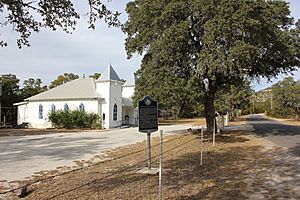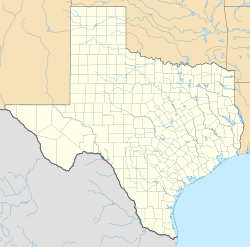Peyton, Texas facts for kids
Quick facts for kids
Peyton, Texas
|
|
|---|---|

Mt. Horeb Baptist Church in Peyton
|
|
| Country | United States |
| State | Texas |
| County | Blanco |
| Elevation | 1,352 ft (412 m) |
| Time zone | UTC-6 (Central (CST)) |
| • Summer (DST) | UTC-5 (CDT) |
| Area code(s) | 830 |
| GNIS feature ID | 1378843 |
Peyton is a small community in Blanco County, Texas. It is called an unincorporated community because it does not have its own local government like a city does. In 2000, about 30 people lived in Peyton.
Contents
The Story of Peyton, Texas
Peyton was started around 1865 by people who had been enslaved but were now free. The community was named after Peyton Roberts, one of the people who helped create it. Peyton was also known by other names like Payton, Peyton Colony, and Boardhouse. The name Boardhouse came from A.V. Walker's house, which was made of boards and served as the first post office in the area.
How Peyton Roberts Started the Community
After he was freed, Peyton Roberts left Lockhart to find a new home. He found land in the area that would become Peyton. Roberts got his land through a process called preemption. This meant he could claim and buy land that was not yet owned. Other early residents also claimed land this way. Even though preemption ended in 1876, some land grants were still given out until 1880.
Peyton had its own post office for a few years. It was open from 1898 to 1909 and again from 1918 to 1930. Even though Peyton has not been shown on county maps since then, it is still a community today. There is also a cemetery in Peyton with 176 graves, including many of the community's first founders.
Peyton Roberts's Early Life
Peyton Roberts was born into slavery in Virginia. In the 1820s, he moved to Texas with his owner, Jeremiah Roberts. They settled in the Bastrop and Caldwell counties area. Later, Peyton and his family became enslaved by Jeremiah's grandson, William.
During the American Civil War, William freed his enslaved people. The freed families agreed to work for William during the war. In return, they received supplies they would need to start their new lives. White settlers called this area "Freedman’s Colony." Most of the people living there worked as farmers.
Building Peyton's Homes
Peyton Roberts also built a lime kiln. A lime kiln is a special oven used to heat limestone. This process creates lime, which is a key ingredient in mortar. Mortar is like a strong glue used to hold bricks and stones together when building houses. The lime from Roberts's kiln was used to build many of the structures in Peyton. The kiln was fixed up in 1960 and is now near a park.
The First Church in Peyton
The first church in Peyton was Mt. Horeb Baptist Church, founded in 1874. Reverend Jack Burch led the church. Jim Upshear, who moved to the area from Virginia with his wife by wagon train, gave the land for the church's permanent location.
Where is Peyton Located?
Peyton is located just west of where Farm to Market Roads 165 and 2325 meet. It is near Boardhouse Creek. Peyton is about 7 miles (11 km) east of Blanco in southeastern Blanco County. It is also about 23 miles (37 km) southeast of Johnson City and 36 miles (58 km) east of Fredericksburg. Larger cities nearby include San Antonio, which is about 56 miles (90 km) north, and Austin, about 40 miles (64 km) southwest.
Learning in Peyton
At first, the Mt. Horeb Baptist Church also served as a school for the community. Later, Peyton built its own small schoolhouse made of logs. This school taught students from grades 1 to 8. It was open from 1877 until 1963. Today, children in the Peyton area attend schools in the Blanco Independent School District.



